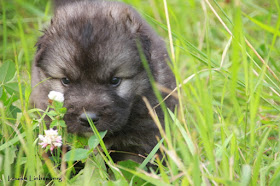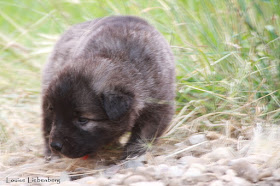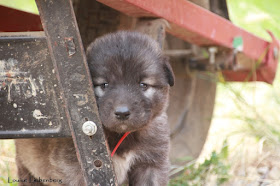Resource Guarding and the LGD
Written for The Shepherds Magazine
Written for The Shepherds Magazine
©Louise Liebenberg, 2018
Just about all Livestock Guardian Dogs (LGD) go through a prominent Resource Guarding
(RG) period as pups. Resource guarding or “possession aggression” can be
defined as the dog showing aggressive forms of behaviour (growling, snapping,
lunging etc.) to ensure that people or other animals stay away from a resource
(food, item, or place) that the dog regards as high value. Typically, it
revolves around food, but with LGD it can extend to newborns, water troughs,
hay feeders, a sleeping area, and toys such as sticks.
Resource guarding is a normal and common behaviour in (wild) canines, as this
will help protect their share in food, help with their survival and establishes
a social hierarchy. It can also be linked to dominance, territorial behaviours,
and aggression. Some breeds show low
levels of this RG trait while others are more reactive in their response. There
is researching suggesting that this trait has a genetic base to it. The degree
of RG a dog shows is a combination of both genetics and learned experience. Given
that LGD have been selected and evolved into protecting a human resource
(livestock), it can be assumed that many LGD will show this behaviour and, that
this trait has a high genetic component for all LGD breeds. Understanding that this is a normal behaviour
in canines does not mean we can ignore it, we need to be vigilant with our LGD
that this behaviour remains contained and within acceptable limits. A warning
to another dog or the livestock to not approach its food is fine, attacking the
livestock or shepherd is not. RG can
escalate very quickly if the dog learns that it is successful in chasing away people
or animals who come too close to its food or possessions. Some dogs will not
just warn the livestock but will run them down quite a way and attempt to bite
them. This is where the shepherd needs to step in a teach the dog that this
escalation is unacceptable.
 |
Resource guarding behaviour between two LGD.
|
What does resource guarding look like? Recognizing the body language early can
help nip this behaviour in the bud. When it comes to food, the dog will stand
directly over its food with its legs on either side. It will look anxiously
around it, stare and growl at other dogs, livestock or people who approach the
dog or its item. It will often stand
with tension, ears back and head low. Some will not eat or stop eating, preferring
to guard their food. They will often have their food between their paws when
laying down. It is a “possessive” position. When they guard a space or inanimate objects like
the water tank, they will lay there and chase anything that approaches it away,
often lunging, snapping, and barking at the animals. When it comes to babies, they will stand over
the baby, keep it between their legs, sometimes carry it around in their mouth.
They will lunge and snap at the mother, at
times biting her face and ears. With
items such as toys and bones, they will often chase livestock and other dogs
away from the area a bone is buried. When dogs show RG behaviour by claiming a
person, the dog will often not allow other dogs close to you, walking right in
front of you, sometimes taking hold of your hand, staring at the other dog, growling
at them, and even attacking another animal who comes close to you. It is a
“claiming” behaviour to hog all your attention.
Sharing is not a strong point for most LGD, particularly when it comes to food.
Some people do not recognise that RG is
the trait and that aggression and dominant behaviour, are often the outward manifestations
of the RG. These three terms, dominance, aggression, and resource guarding are
all different. There is a clear
difference between a dog who is aggressive and a dog who is resource guarding, not
all dominant dogs are aggressive, and some never display RG tendencies.
 |
| This dog is snarling to warning another dog away from its meat, this is very typical RG behaviour. |
Most of the time the dog that is RG is issuing a warning to you or another animal
to stay away.
Ordinarily, the resource is food, but can also be things such as bones, sticks,
toys, a sleeping area, the water tank, another dog, the hay feeder, a space, a
person, a newborn baby, a carcass of an animal that has died or even a specific animal. When the dogs start to escalate this behaviour
towards the livestock, then the boundaries of good behaviour are overstepped.
If RG extends to newborn animals and results in the LGD claiming the baby and
keeping mothers and babies separated, it becomes a big problem for the shepherd.
Frequently, people misunderstand this
behaviour thinking that the LGD is being caring and nurturing when it is in
fact claiming the baby. As babies need the colostrum directly, a dog that does
this could cause the baby to die or weaken. Some dogs even regard the baby as a
food resource and will kill and eat it. So, this is certainly behaviour that
needs to stop. The role of the guardian is not to take over the mother’s job,
instead it is to watch over them, protect them and allow the mother to bond and
feed her own baby. The dog needs to butt out of the birthing process and simply
do his job of watching over and being vigilant for predators.
Resource guarding (RG) is not a bad thing, but it certain does require some
attention to prevent escalation. We have found that our dogs have learnt to
guard against aerial predators through RG. Ravens will try to steal their food
and the LGDs have learned to chase the ravens away. This behaviour has
escalated in a good way, by the dogs now chasing off ravens and eagles in the
pasture with newborn animals. The dogs have learned to guard against aerial
predators by resource guarding their food. In a study in the Europe, French
researcher Jean Marc Landry, found that dogs who show strong resource guarding
behaviours were often more determined and aggressive towards predators than
those who showed little RG behaviour. He suggested that the RG could be used as
selection criteria for breeders of LGD. Guardian dogs who defend a carcass from wolves,
were more determined in chasing off predators.
So, RG is a bit like a double-edged sword, it is an important quality in an LGD,
but it is also something that does need some parameters and boundaries. I know
that if we feed kibble to our dogs, the sheep will swarm the dog to try and eat
the kibble. Kibble is not food for sheep and by law, they should not be eating
it.
I want my dogs to RG their kibble from the livestock. They “must” defend their food, however in doing so, they may not hurt the livestock or intensify this behaviour. There are limitations that I place on the dogs when it comes to the intensity of RG. They can chase the livestock a short distance away provided it is done in fairness and with restraint. I do not want my dogs to bite the livestock or chase them all over the pasture. They need to be moderate in their reaction.
 |
| This LGD is showing no resource guarding behaviour for her kibble. This is very frustrating seeing the sheep eating the food of the dog. |
I want my dogs to RG their kibble from the livestock. They “must” defend their food, however in doing so, they may not hurt the livestock or intensify this behaviour. There are limitations that I place on the dogs when it comes to the intensity of RG. They can chase the livestock a short distance away provided it is done in fairness and with restraint. I do not want my dogs to bite the livestock or chase them all over the pasture. They need to be moderate in their reaction.
 |
| These LGD have chased the sheep a few feet away, and the ewes have accepted this and are not attempting to eat the food of the dogs. |
These are fine lines that need to be drawn and mostly these
need to be established when the dog is young. Just about every single LGD pup
will attempt to growl when you feed him, it is at this point when the pup needs
to be corrected for this. I do not advocate for things such as alpha rolls, or
biting ears, or shaking a pup as this often exacerbates the problem as the dog
now feels he needs to protect himself and his food. I find the best way to deal with this is a
verbal reprimand and if more is required chasing the pup away. Having a
respectful relationship with the young dog really does mean that a verbal
reprimand is often enough. Some dogs do get bullied away from their food by the
livestock or other dogs, and that is where tying them up or feeding them away
from the livestock is a good idea. This tethering is also a great way to just
let them calm down and be patient while you feed.
Another idea is to set up a feeding station where the dogs can come and go as they please, an area the livestock cannot get into. Most pups learn quickly that RG of food is not necessary, provided they have plenty of quality food. As LGD should be living out in the pasture there is space to feed, and personally I do not see why anyone needs to mess with a dog while it is eating. If they have no reason to RG their food, they mature, and are usually unconcerned about it. With dogs under a year old I generally do not accept any form of RG towards the livestock, as I find young dogs have not yet learnt how to moderate their reaction. Stopping it at this stage is easier than stopping it as a mature dog. As the dog matures and he shows restraint in his RG behaviour, then I will let it go. I find working this way, the mature dog rarely oversteps the boundaries, as the basis for good behaviour was established as a young dog. A reminder/reprimand is occasionally given if the dog shows an escalation, just to ensure the dog is aware that you are watching him.
 |
| Tethering for feeding is a good option. |
Another idea is to set up a feeding station where the dogs can come and go as they please, an area the livestock cannot get into. Most pups learn quickly that RG of food is not necessary, provided they have plenty of quality food. As LGD should be living out in the pasture there is space to feed, and personally I do not see why anyone needs to mess with a dog while it is eating. If they have no reason to RG their food, they mature, and are usually unconcerned about it. With dogs under a year old I generally do not accept any form of RG towards the livestock, as I find young dogs have not yet learnt how to moderate their reaction. Stopping it at this stage is easier than stopping it as a mature dog. As the dog matures and he shows restraint in his RG behaviour, then I will let it go. I find working this way, the mature dog rarely oversteps the boundaries, as the basis for good behaviour was established as a young dog. A reminder/reprimand is occasionally given if the dog shows an escalation, just to ensure the dog is aware that you are watching him.
 |
A dog guarding a carcass, ensuring predators and scavengers stay away.
While on this topic, a thought occurred to me that, maybe, the overriding trait in LGDs is not so much the nurturing and protection part, but perhaps they see the livestock as a resource for themselves and that resource needs to be guarded from other canines. Perhaps, the livestock guardian dog instinct evolved from resource guarding, similarly, as the herding instinct of a border collie is evolved out of a hunting sequence. I think a lot of guarding behaviour stems from RG, however the dog learns to be protective without the need to be aggressive. Ah, all these interesting LGD related thoughts to ponder on the tractor this hay making season!
 |
Sharing resources.
 | ||
|



































































